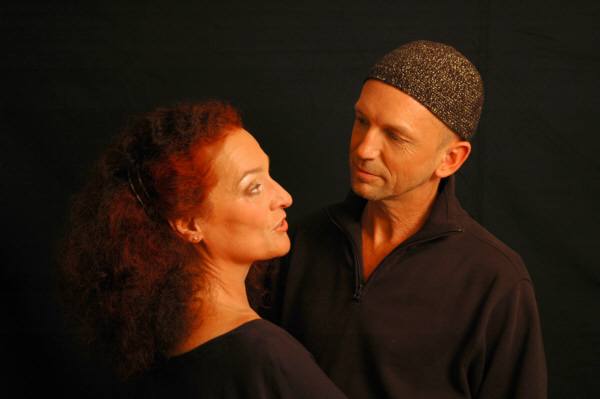ensemble | vitae | cds | contact
|
|
|
|
|
Stephanie Haas: voice, percussion |
|
Ensemble Cosmedin invites the audience to discover anew the meditative beauty and the spirituality of early music. The ensemble derives its main inspiration from mediaeval sacred music of the Middle Ages, while their delight in improvisation and experiment creates a bridge to contemporary music. "Their performances succeed in blending contrasting mentalities and styles. The minimalism of their means is the point of encounter between the Middle Ages and the present." Markus Dippold |
|
Ensemble Cosmedin is considered to be one of the most prominent ensembles for medieval and contemporary sacred music. Concerts in the cathedrals of Chartres and Vézelay, Cologne, Speyer, Bamberg, Limburg, Frankfurt, Naumburg, Chur, Mainz and Trier, in the Palatine Chapel Aachen, in Müstair, Ascona, Lugano, St. Gallen, Amsterdam, Straßburg, Ulm Minster, Milan, Paris, Berlin. Invitations to festivals (Voix et Route Romane, Festival Europäische Kirchenmusik, Hildegard-Herbst Bingen, Nibelungen-Festspiele Worms, Kultursommer Rheinland-Pfalz), CDs, TV- und Radio-Features. |
|
"Ensemble Cosmedin demonstrates with feeling and sensitivity how mediaeval music can be brought to life. Their subtle interpretations of pre-Gregorian chorales, works by Hrabanus Maurus, Abaelard, Hildegard von Bingen and Leonin are based on a detailed study of the manuscript sources." Werner M. Grimmel |
|
Their concerts unfold in a harmonic tension between the vocal lines of the chorale and instrumental compositions. |
|
"Since 1999, the artist duo Stephanie and Christoph Haas have been working as Ensemble Cosmedin on innovative approaches to early music. Their repertoire, documented on several CDs, spans from pre-Gregorian chant via Hrabanus Maurus, Hildegard of Bingen and Leonin to present-day music (Milko Kelemen, Sofia Gubaidulina, Aribert Reimann and others). The moving solo voice acts in counterpoint to the instruments, whose origins lie in the Middle East." Stephan Rommelspacher (Cathedral music director, Trier) |
|
A great voice „Your concert at the cathedral was really a great moment. I've heard a lot of interpretations of Hildegard's music since 1994, year of our very first concert, and I confirm that Stephanie is a great voice!“ Lorant Hecquet (promoter of the Cathedral concerts) Vézelay, September 2013 |
|
A dialogue across the boundaries of time "Stephanie and Christoph Haas carry out a dialogue across the boundaries of time - between the sacred music of the middle ages and contemporary compositions. Magnificent, fresh and dynamic interpretations of some of the most challenging chants of the middle ages by Hildegard von Bingen, Pierre Abaelard, Leoninus and others - confronted and merged with the compositions of Milko Kelemen, Sophia Gubaidulina, Aribert Reimann, Joanne Metcalf and Christoph Haas. The Ensemble Cosmedin has achieved the musical transformation of a supracultural vision: that of man rooted in the earth, but reaching up to heaven. The 12th century, in which the songs of Hildegard von Bingen were written, was a time of cross-frontier communication, of intellectual expansion, of curiosity and willingness to enter into dialogue with what was different and "foreign". It was in this century that Petrus Venerabilis, the Abbot of Cluny, ordered a Latin translation of the Koran, to enable himself and others to hold well-founded discussions with the Moslems. It was also in this century that Pierre Abaelard wrote his dialogue between a Moslem, a Jew and a Christian. Hildegard von Bingen held discussions with Jewish theologians in her convent. The instrumental compositions of Christoph Haas focus on the origins of European sacred music, which was strongly influenced and enriched by oriental traditions." Dr. Barbara Stühlmeyer (musicologist) |
|
Enlightened |
|
Ruby Sacred Music of the Middle Ages Love, fervour and passion dwell within the ruby in crystal form. Its lucent red is a symbol of our innermost heart and was the inspiration that led to this selection of meditative spiritual music of the Middle Ages and the present day. Pre-Gregorian chorales from the Lateran Basilica, poetry of Hrabanus Maurus (780 - 856) in ancient verse form, compositions by Abelard (1079 - 1142), Hildegard of Bingen (1098 - 1179) and Leonin (Notre-Dame Paris about 1180) encounter the music of Christoph Haas, with its characteristic accentuated rhythms and airy lightness. Ensemble Cosmedin present this mediaeval vocal music with great sensitivity and glowing intensity, inviting us to rediscover the beauty and spirituality of music from ancient times. The inherent dynamism and drama of the sung words is intensified by their strict adherence to the text, based on the study of early handwritten sources. more ... |

